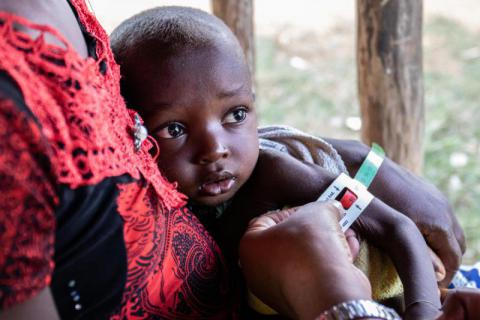The number of acutely malnourished children under five in cyclone-hit areas in Mozambique is expected to jump from nearly 60,000 to 115,000 after crops and livelihoods were swept away by the storm, Save the Children warned April 25, 2019.
Thousands of children in the disaster-struck areas were already on the brink of hunger when Cyclone Idai made landfall on 14 March 2019. The rains, winds, and floods destroyed 715,300 hectares of crops just before the harvest – about 13 percent of the farmland in Mozambique, an area with the equivalent of almost 1 million football fields – placing more children at risk of malnutrition.
With a new cyclone, Kenneth bound to make landfall in the north of Mozambique later today, just over a month after cyclone Idai, these numbers might rise even further. Save the Children is concerned about the potential impact of this new cyclone on children and is assessing response options.
“In the areas already hit by cyclone Idai, time to replant crops is running out by the day. Hundreds of thousands of families will be left without an income until the next harvest, and their children without enough to eat,” said Getinet Babu, nutrition advisor for Save the Children in Mozambique.
“Last week we met a woman who was using a stick to dig through a meter of dry mud so she could re-plant her maize crop. She had only managed to salvage an armful of maize to feed her children for the foreseeable future. The rest of her crop was destroyed in the floods.”
A shortage of nutritious food and a lack of sustained breastfeeding for infants less than six months old can lead to acute malnutrition among children, which was already a problem in Mozambique before the cyclone. An estimated 88,000 pregnant women and mothers of babies less than six months are also expected to need nutritional support.
“In the short-term, acutely malnourished children have weak immune systems and are more susceptible to dying from preventable diseases such as measles and diarrhea. In the long-term, if a malnourished child survives, its development can be severely impacted – malnutrition stunts the growth of vital organs and body functions irreversibly. Urgent action is needed – tens of thousands of children in these disaster-affected areas might not survive to see their fifth birthday.
“Save the Children is calling for more funding to sustain food distributions, which need to include extra nutritious rations for malnourished children, to prevent a slide into acute malnutrition. Mothers also need to receive support to continue breastfeeding, which is vital for children’s health and development.”
Joice, 19, had a small farm in Manica province, which was completely in the cyclone. Recently she took her son Johan, 19 months, to a mobile clinic run by Save the Children’s Emergency Health Unit. The doctors diagnosed Johan with severe malnutrition and malaria, after which he was transported to the nearest hospital.
Joice said: “The cyclone took all our food, two houses, and our clothes. It took our chickens – and all the animals we had. We were growing rice, vegetables, and sweet potatoes, but everything is gone. We haven’t started farming again because we don’t have the seeds. Life is very difficult because we don’t have anything to eat.
“I came to the clinic today because my son has not been well. He has pain all over his body, he doesn’t eat and he’s losing weight. He weighs just over six kilograms. That’s what motivated me to come to the clinic.”
To meet the immediate needs of the affected families, Save the Children is distributing food in some of the hardest hit areas. Together with the government, the UN and other agencies, more than 1 million people have been reached with food assistance so far.
Save the Children is also distributing seeds and tools so families can replace their lost crops and rebuild their lives, and the organization’s Emergency Health Unit is identifying malnourished children providing them with life-saving high-energy peanut paste and referring them on for further care.

© Save the Children
Population of Malnourished Children Likely to Double in Mozambique
Crop Failures Adding to Crisis


